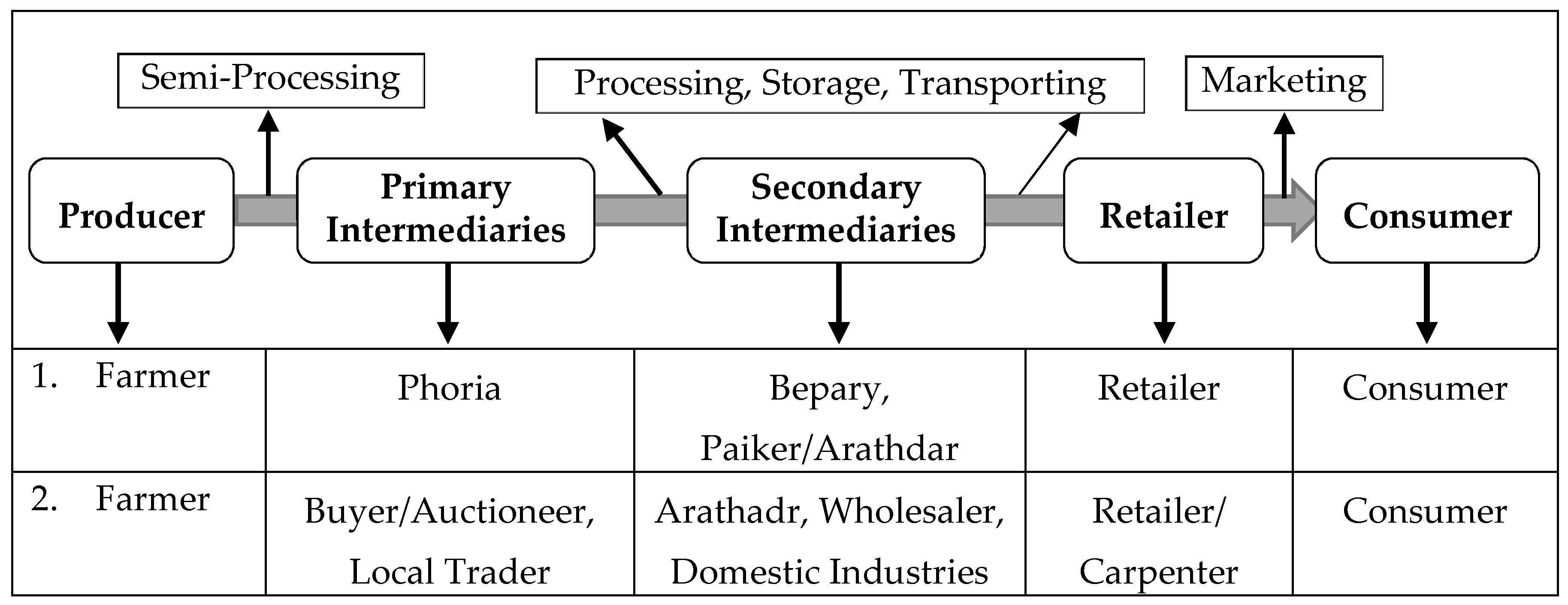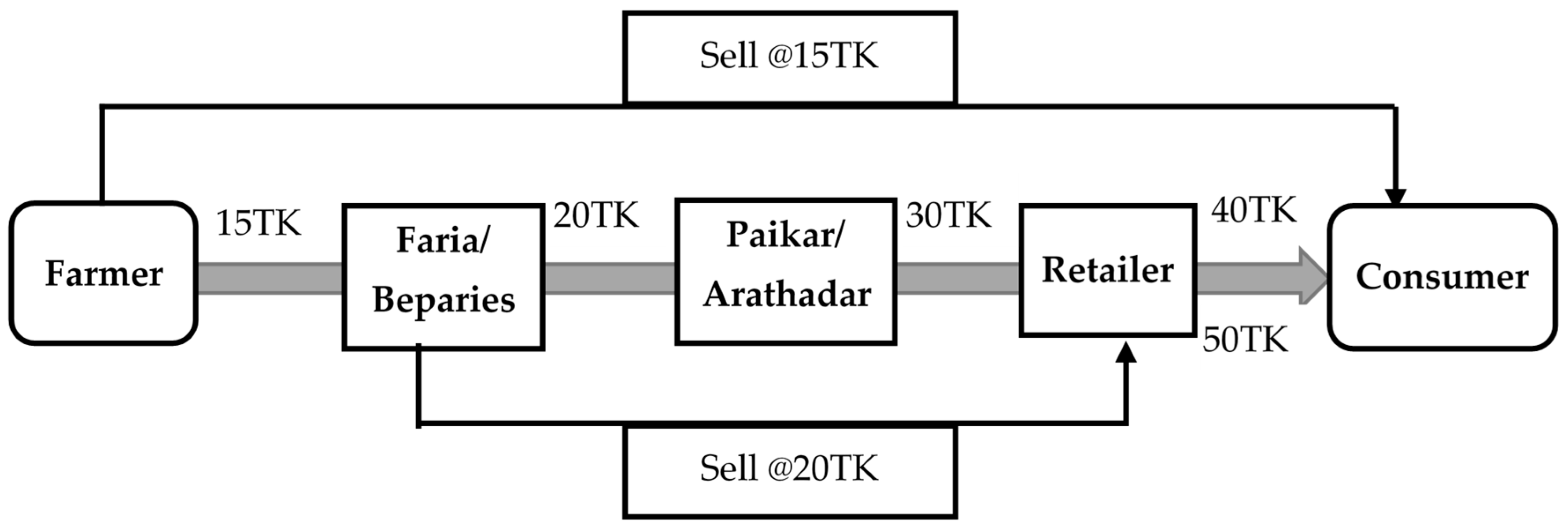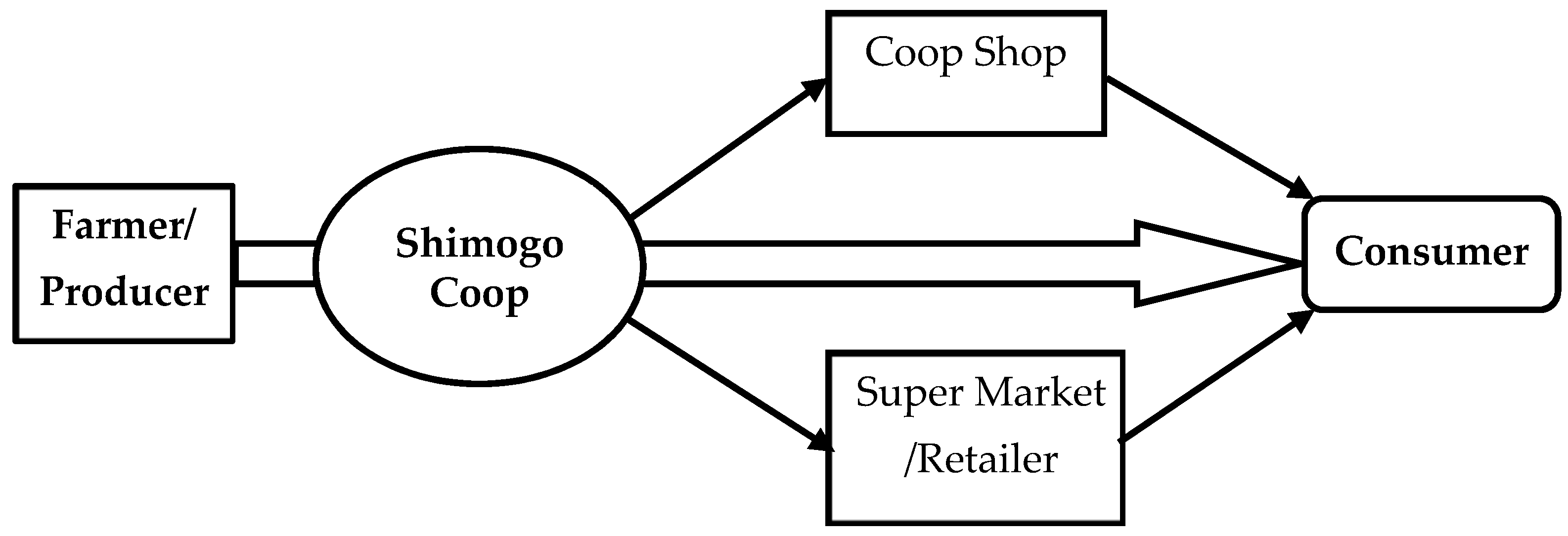Evolving and Strengthening the Cooperative Approach for Agroforestry Farmers in Bangladesh: Lessons Learned from the Shimogo Cooperative in Japan
Abstract
:1. Introduction
2. Methods and Materials
2.1. Conceptual and Theoretical Frameworks
2.2. Madhupur Agroforestry Case of Bangladesh
2.3. Oita Cooperative Case of Japan
2.4. Data Collection and Analysis
3. Results and Discussion
3.1. Problem Analysis of Agroforestry in Bangladesh
3.2. Intermediaries Involved in the Agroforestry Product Supply Chain in Bangladesh
3.2.1. Phoria
3.2.2. Beparies
3.2.3. Paiker/Arathdar
3.2.4. Retailer
3.2.5. Buyer/Auctioneer
3.2.6. Local Firewood Trader
3.3. Effects of Intermediaries on Farmer Products
3.4. Way Out of Issues
3.5. Agriculture Cooperatives in Japan
3.5.1. Institutions and Organization of the Shimogo Cooperative
3.5.2. Marketing and Other Services of the Shimogo Coop
3.5.3. Welfare of Shimogo Coop
3.5.4. Challenges of the Shimogo Coop
3.6. Lessons to Be Learned
4. Conclusions
Acknowledgments
Author Contributions
Conflicts of Interest
References
- World Bank. Bangladesh: Growing the Economic through Advances in Agriculture. 2016. Available online: http://www.worldbank.org/en/country/bangladesh (accessed on 13 November 2015).
- FAO. Farmers’ Organization in Bangladesh: A Mapping and Capacity Assessment. 2014. Available online: http://www.fao.org/docrep/019/i3593e/i3593e.pdf (accessed on 27 June 2017).
- Ali, M.M.; Islam, A.M. Developing Agribusiness Strategies for Bangladesh—An Analysis. American University in Bangladesh Economic Working Paper. 2011. Available online: https://orp.aiub.edu/ (accessed on 6 July 2017).
- Islam, K.K.; Sato, N.; Hoogstra, M. Poverty alleviation in Bangladesh: The case of the participatory agroforestry program. Int. For. Rev. 2010, 12, 412–415. [Google Scholar]
- Islam, K.K.; Sato, N. Deforestation, land conversion and illegal logging in Bangladesh: The case of the Sal (Shorea robusta) forests. iFor. Biogeosci. For. 2012, 5, 171–178. [Google Scholar] [CrossRef]
- Islam, K.K.; Jose, S.; Tani, M.; Hyakumura, K.; Krott, M.; Sato, N. Does actor power impede outcomes in participatory agroforestry approach? Evidence from Sal forests area, Bangladesh. Agrofor. Syst. 2015, 89, 885–899. [Google Scholar] [CrossRef]
- Safa, M.S. The effect of participatory forest management on the livelihood of the settlers in a rehabilitation program of degraded forest in Bangladesh. Small-Scale For. Econ. Manag. Policy 2004, 3, 223–238. [Google Scholar]
- Muhammed, N.; Koike, M.; Haque, F.; Miah, M.D. Quantitative assessment of people oriented forestry in Bangladesh: A case study from Tangail Forest Division. J. Environ. Manag. 2008, 88, 83–92. [Google Scholar] [CrossRef] [PubMed]
- Islam, K.K.; Sato, N. Participatory forestry in Bangladesh: Has it helped to increase livelihoods of Sal forests dependent poor people. South. For. 2012, 74, 89–101. [Google Scholar] [CrossRef]
- Kirimi, L.; Sitoko, N.; Jayne, T.S.; Karin, F.; Muyanga, M.; Sheahan, M.; Flock, J.; Bor, G. A Farm Gate-To-Consumer Value Chain Analysis of Kenya’s Maize Marketing System; MSU International Development Working Paper No. 111. Michigan State University, 2011. Available online: http://fsg.afre.msu.edu/papers/idwp111.pdf (accessed on 21 October 2017).
- Islam, K.K.; Ullah, M.O.; Hoogstra, M.; Sato, N. Economic contribution of participatory Agroforestry program to poverty alleviation: A case from Sal forests, Bangladesh. J. For. Res. 2012, 23, 323–332. [Google Scholar] [CrossRef]
- Islam, K.K.; Rahman, G.M.; Fujiwara, T.; Sato, N. People’s participation in forest conservation and livelihoods improvements: Experience from a forestry project in Bangladesh. Int. J. Biodivers. Sci. Ecosyst. Serv. Manag. 2013, 9, 30–43. [Google Scholar] [CrossRef]
- Gain, P. The Last Forest of Bangladesh; Society for Environmental and Human Development (SEHD): Dhaka, Bangladesh, 2002; ISBN 984-494-0192. [Google Scholar]
- Matin, M.A.; Baset, M.A.; Alam, Q.M.; Karim, M.R.; Hasan, M.R. Mango marketing system in selected areas of Bangladesh. Bangladesh J. Agric. Res. 2008, 33, 427–438. [Google Scholar] [CrossRef]
- Scott, G.J. Marketing Bangladesh’s Potato: Present Patterns and Future Prospects; Report on CIP-ADAB; International Potato Center: Lima, Peru, 1998; pp. 43–53. [Google Scholar]
- Islam, K.K.; Kimihiko, H.; Takahiro, F.; Sato, N. Confronting people-oriented forest management realities in Bangladesh: An analysis of actors’ perspective. Int. J. Soc. For. 2011, 4, 153–179. [Google Scholar]
- Kohls, R.L.; Uhl, J.N. Marketing for Agricultural Products, 9th ed.; Macmillan Publishing Company: New York, NY, USA, 2005; ISBN 978-0130105844. [Google Scholar]
- Prakash, D. Development of Agriculture Cooperative: Relevance of Japanese Experiences to Developing Countries; Paper Presented at the ICA-Japan International Training Course; Rural Development and Management Centre Publication: New Delhi, India, 2000; pp. 2–13. [Google Scholar]
- Zhang, X.; Huang, Y. The agricultural Co-operatives in China. Int. J. Bus. Manag. 2009, 4, 106–110. [Google Scholar] [CrossRef]
- Esham, M.; Kobayashi, H.; Matsumura, I.; Alam, A. Japanese agricultural cooperatives at crossroad: A review. Am.-Eur. J. Agric. Environ. Sci. 2012, 12, 943–953. [Google Scholar]
- Singh, K. Rural Development: Principles, Policies and Management; Sage Publication: New Delhi, India, 2009; ISBN 9788178299266. [Google Scholar]
- Rajaratne, A.R. Roles and effectiveness of agricultural cooperatives in Japan, with special emphasis on organized farm activities. J. Dev. Sustain. Agric. 2007, 2, 192–198. [Google Scholar]
- Ishida, M. Development of Agricultural Cooperatives in Japan; FAO: Rome, Italy, 2002; Available online: http://agris.fao.org/agris-search/search.do?recordID=JP2002004978 (accessed on 6 July 2017).
- Godo, Y. The Japanese Agricultural Cooperative Systems: An Outline; Food and Fertilizer Technology Centre (FFTC) Agriculture Policy Article; FFTC Publishers: Taipei, Taiwan, 2014. [Google Scholar]
- Kurimoto, A. Agricultural Cooperatives in Japan: An institutional approach. J. Rural Coop. 2004, 32, 111–128. [Google Scholar]
- Kazuhito, Y. Understanding the Japan Agriculture Cooperative. 2013. Available online: https://www.nippon.com/en/currents/d00082/ (accessed on 22 January 2018).
- Ahmed, J.D. Study on Sustainable Development Conditions of Dairy Farming: Case Studies from Japan and Bangladesh. Ph.D. Thesis, The United Graduate School of Agricultural Sciences, University of Kagoshima, Kagoshima, Japan, 2004. [Google Scholar]
- Zeuli, K.A.; Cropp, R. Cooperatives: Principal and Practices in the 21st Centuries. NCBA: USA, 2004. Available online: http://learningstore.uwex.edu/assets/pdfs/A1457.pdf (accessed on 13 August 2017).
- Rahman, M.A.; Miah, M.D. Are protected forests of Bangladesh prepared for the implementation of REED+? A forest governance analysis from Rema-Kalenga wildlife sanctuary. Environments 2017, 4, 43. [Google Scholar] [CrossRef]
- Alam, M.; Furukawa, Y.; Sarker, S.K.; Ahmed, R. Sustainability of Sal (Shorea robusta) forest in Bangladesh: past, present and future actions. Int. For. Rev. 2008, 10, 29–37. [Google Scholar] [CrossRef]
- Tasnoova, S.; Iwamoto, I. Kataribjog rice marketing system in Dinajpur District, Bangladesh. J. Fac. Agric. Kagoshima Univ. 2006, 41, 19–50. [Google Scholar]
- Asogwa, B.C.; Okwoche, V.A. Marketing of agricultural produce among rural farm household in Nigeria: the case of Sorghum marketing in Benue State. Int. J. Bus. Soc. Sci. 2012, 3, 269–277. [Google Scholar]
- Movsisyan, S. The Role of Cooperatives in the Development of Agriculture of Armenia, Asian Countries and Europe (Worldwide Case Studies); Research Paper; Institute for Cultural Diplomacy (ICD): Berlin, Germany, 2013; Available online: http://www.culturaldiplomacy.org/academy/content/pdf/participant-papers/2013-09-emr/Suren_Movsisyan_-_The_Role_of_Cooperatives_in_the_Development_of_Agriculture_in_Armenia.pdf (accessed on 18 August 2017).
- Fischer, E.; Qaim, M. Linking smallholder to markets: determinants and impacts of farmer collective action in Kenya. World Dev. 2012, 6, 1255–1268. [Google Scholar] [CrossRef]
- Dhital, R. Rural Urban Agriculture Marketing System: Challenges and Opportunities: A Case Study: Eastern Nepal. Master’s Thesis, The School of Forestry and Environmental Studies, Yale University, New Haven, CT, USA, 2004. [Google Scholar]
- Reed, G.; Hickey, G.M. Contrasting innovation networks in smallholder agriculture producer cooperatives: Insights from the Niayes Region of Senegal. J. Co-Oper. Organ. Manag. 2016, 4, 97–107. [Google Scholar]
- Shiferaw, B.A.; Okello, J.; Reddy, R.V. Adoption and adaptation of natural resource management innovations in smallholder agriculture: Reflections on key lessons and best practices. Environ. Dev. Sustain. 2009, 11, 601–619. [Google Scholar] [CrossRef]
- Kurimoto, A. Current State of Co-Operative Research in Asia and Future Strategies. Consumer Co-Operative Institute of Japan Publication, 2011. Available online: http://www.un.org/esa/socdev/social/meetings/egm11/documents/Kurimoto%20-%20Current%20State%20of%20Cooperative%20Research%20in%20Asia.pdf (accessed on 12 January 2018).
- Laidlaw, A.F. Cooperative in the Year 2000; International Cooperative Alliance, Ottawa Cooperative Union Publication: Ottawa, ON, Canada, 1981; ISBN 0920779026 9780920779026. [Google Scholar]
- Kiruthiga, K.; Karthi, R.; Daisy, B.A. Agricultural marketing: An overview. Int. J. Sci. Res. Publ. 2015, 5, 1–2. [Google Scholar]
- Alam, M.F.; Palash, M.S.; Mian, M.A.I.; Dey, M.M. Marketing of Major Fish Species in Bangladesh: A Value Chain Analysis; FAO: Dhaka, Bangladesh, 2012; p. 4. [Google Scholar]
- Tanaka, H. Mergers and structural reorganization of agricultural cooperatives in Japan. In Strategies and Structures in the Agro-Food Industries; Nilsson, J., Van Dijik, G., Eds.; Van Gorcum and Company: Assen, The Netherlands, 1997; pp. 183–193. [Google Scholar]
- Goedde, L.; Fischer, J.; Denis, N.; Tanaka, M.; Yamada, Y. Empowering Japanese Agriculture for Global Impact; McKinsey & Company Publisher: Tokyo, Japan, 2016. [Google Scholar]
- UN. World Population Ageing. United Nation, Department of Economics and Social Affairs, Population Division, 2015. Available online: http://www.un.org/en/development/desa/population/publications/pdf/ageing/WPA2015_Report.pdf (accessed on 13 December 2017).
- Wanyama, F.O. Cooperatives and the Sustainable Development Goals: A Contribution to the Post-2015 Development Debate; International Cooperative Alliance Publication: Brussel, Belgium, 2014. [Google Scholar]







| Rank Order | Problems | Issues in Brief | Freq. (% of Farmer) |
|---|---|---|---|
| 1 | Involvement of many intermediaries | Different middlemen involved in marketing of agroforestry products and the supply chain | 117 (98) |
| 2 | Bureaucratic and official complexity | Complexity and unexpected delays created by the Forest Department staff to initiate Agroforestry programs | 95 (79) |
| 3 | Lack of alternative market facilities | No other suitable market in the local area | 92 (77) |
| 4 | Lack of easy credit or loan facilities | Government and Non-government organizations do not provide interest-free or low-interest loans | 76 (63) |
| 5 | Poor road communication | Often transporting of AF products to the market faced muddy and poor road infrastructure | 74 (62) |
| 6 | Lack of healthy seeds, fertilizers, and pesticides | Unavailability of improved input materials for the local farmers | 69 (58) |
| 7 | Local leader/elite interference | Getting undue benefit from the agroforestry programs | 52 (43) |
| 8 | Lack of information and research | No research and information facilities for the local farmers | 36 (30) |
| Produces | Unit | Producer Price (Taka), P | Retail Price (Taka), R | Marketing Margin = (R − P)/R × 100 |
|---|---|---|---|---|
| Pineapple | 1 piece | 15 | 40 | 62.5% |
| Ginger | 1 kg | 70 | 125 | 44.0% |
| Turmeric | 1 kg | 30 | 45 | 33.3% |
| Firewood (Acacia spp.) | 1 mon (40 kg) | 120 | 190 | 36.8% |
| Firewood (Other spp.) | 1 mon (40 kg) | 100 | 175 | 42.9% |
| Types of Meeting | Time | Actors Involved | Major Issues |
|---|---|---|---|
| Own farmer group meeting | Once a month, as per need | Planning commission, farmer group | Evaluate production, costs, and other problems |
| All farmers, group meeting | At least once in a three-month period, as per need | All farmers, planning commission | Production costs in particular sessions, problems, planning |
| Farmer with coop staff meeting | Three times a year, as per need | Farmer and particular staff | Fix product-selling prices, evaluate consumer feedback, farmer problems, etc. |
| Board meeting | Once a month | Board members | Discuss different strategies related to production, selling, and overall issues |
| Staff meeting | Once a month, as per need | All staff | Evaluate each group’s progress, farmer problems, future planning, and other issues |
| General meeting | Once a year | All farmers and coop staff | Evaluation, next year budget, future plans, and other broad decisions |
© 2018 by the authors. Licensee MDPI, Basel, Switzerland. This article is an open access article distributed under the terms and conditions of the Creative Commons Attribution (CC BY) license (http://creativecommons.org/licenses/by/4.0/).
Share and Cite
Islam, K.K.; Fujiwara, T.; Sato, N.; Hyakumura, K. Evolving and Strengthening the Cooperative Approach for Agroforestry Farmers in Bangladesh: Lessons Learned from the Shimogo Cooperative in Japan. Sustainability 2018, 10, 617. https://doi.org/10.3390/su10030617
Islam KK, Fujiwara T, Sato N, Hyakumura K. Evolving and Strengthening the Cooperative Approach for Agroforestry Farmers in Bangladesh: Lessons Learned from the Shimogo Cooperative in Japan. Sustainability. 2018; 10(3):617. https://doi.org/10.3390/su10030617
Chicago/Turabian StyleIslam, Kazi Kamrul, Takahiro Fujiwara, Noriko Sato, and Kimihiko Hyakumura. 2018. "Evolving and Strengthening the Cooperative Approach for Agroforestry Farmers in Bangladesh: Lessons Learned from the Shimogo Cooperative in Japan" Sustainability 10, no. 3: 617. https://doi.org/10.3390/su10030617







